We’ve all been there – the perfect summer barbecue suddenly dampened by fatigue, headaches, or worse, as the heat and festivities take their toll. What’s often the silent culprit? Dehydration. While we meticulously plan our menu and decorations, proper hydration at barbecues frequently takes a backseat, yet it’s arguably the most critical factor in ensuring everyone enjoys the event from start to finish.
Proper hydration doesn’t just prevent discomfort—it actively enhances your barbecue experience. Well-hydrated guests are more energetic, engage in better conversations, and have more fun. As a host, your attention to hydration needs can be the difference between a gathering that fizzles out early and one that creates lasting memories.
According to recent studies, over 75% of Americans are chronically dehydrated, and this percentage spikes during summer outdoor gatherings. Even mild dehydration, as little as 1-2% of body weight, can impair cognitive function, dampen mood, and reduce energy levels. At a barbecue, where sun exposure, heat, and often alcohol consumption combine, dehydration risks multiply significantly.
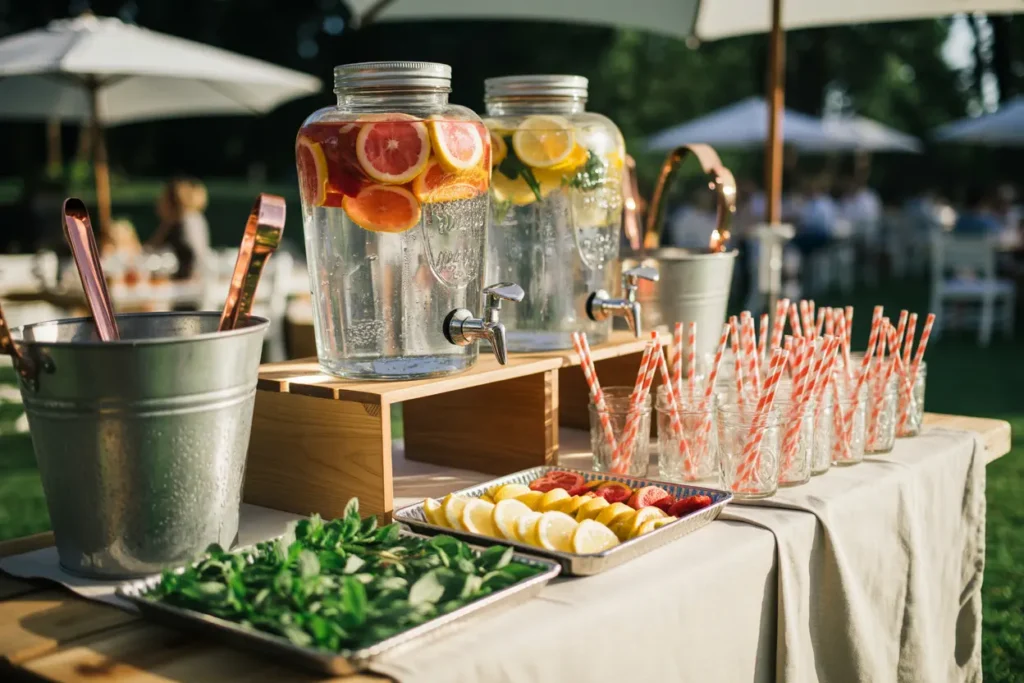
Understanding Hydration Science: Why Water Matters More at Summer Barbecues
When you’re enjoying that perfectly grilled burger under the summer sun, your body is working overtime to maintain its ideal temperature. Unlike indoor dining, outdoor barbecues expose you to direct sunlight, elevated temperatures, and often higher humidity—all factors that significantly increase your body’s water needs.
During a typical summer barbecue, you might lose between 16-32 ounces of water per hour through perspiration alone. This perspiration is your body’s natural cooling system, but it requires constant replenishment to function effectively.
“Most people don’t realize they’re already mildly dehydrated by the time they feel thirsty,” explains Dr. Maria Gonzalez, sports medicine specialist. “At outdoor events like barbecues, where you’re distracted by socialization and activities, you might ignore early dehydration signals.”
That refreshing beer or summer cocktail comes with a hidden cost to your hydration levels. Alcohol is a diuretic, meaning it increases urine production and accelerates fluid loss. For every alcoholic beverage you consume, you may need an additional 8-12 ounces of water to maintain hydration.
| Dehydration Symptom | Quick Solution | Prevention Strategy |
|---|---|---|
| Thirst | Drink 8-16 oz of water immediately | Drink water consistently throughout the event |
| Headache | Rest in shade with water and electrolytes | Alternate alcoholic drinks with water |
| Fatigue | Rest in the shade with water and electrolytes | Pre-hydrate before the barbecue |
| Dizziness | Sit down, rehydrate, and cool off | Monitor urine color (should be light yellow) |
| Muscle cramps | Sit or lie down, and seek medical help if severe | Include electrolyte-rich foods in your barbecue menu |
| Dry mouth | Sip water slowly but consistently | Consume electrolytes, and gentle stretching |
| Decreased urination | Increase water intake immediately | Aim for hydration station visits every 30-45 minutes |
Optimal Fluid Intake Guidelines for Outdoor Events
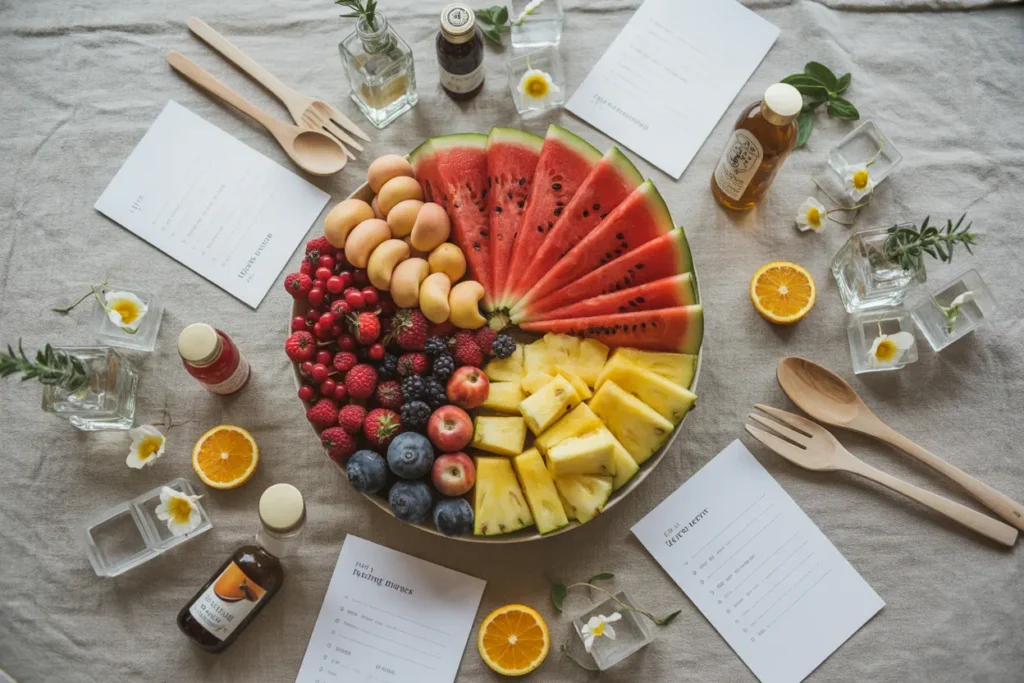
A general guideline is to consume 0.5-1 ounce of water per pound of body weight daily. For a 150-pound person, that translates to 75-150 ounces of water (about 9-19 cups). However, during a summer barbecue, you should aim for the higher end of this range.
For every 10-degree increase above 80°F, you should add approximately 12-16 additional ounces of water to your daily intake. High humidity makes this even more crucial since your sweat doesn’t evaporate efficiently, reducing your body’s natural cooling mechanism.
Children and older adults have unique hydration needs that require special attention at outdoor events like barbecues. Children lose water more quickly than adults due to their higher surface-area-to-body-weight ratio and often don’t recognize thirst signals until they’re already dehydrated. For seniors, the thirst response naturally diminishes with age, making them particularly vulnerable to dehydration.
Recognizing Dehydration Warning Signs Before They Become Serious
Catching dehydration early can prevent a minor discomfort from escalating into a genuine health emergency. Early signs to watch for in yourself and guests include:
- Increased thirst (though this is often a late indicator)
- Dry or sticky mouth
- Reduced urination or darker yellow urine
- Fatigue or unexplained tiredness
- Headache
- Dry, cool skin
- Muscle cramps
- Decreased conversation participation or engagement
Understanding the progression from dehydration to more serious heat-related illnesses is essential for barbecue hosts. Heat exhaustion symptoms include heavy sweating, paleness, muscle cramps, weakness, dizziness, headache, nausea, and fainting. While serious, heat exhaustion can typically be resolved with rehydration, cooling, and rest.
Heat stroke, however, is a life-threatening emergency characterized by a body temperature above 103°F, red, hot, dry skin (often with no sweating), rapid pulse, throbbing headache, dizziness, nausea, confusion, and potential unconsciousness.
Planning Your Barbecue’s Hydration Strategy: A Host’s Guide
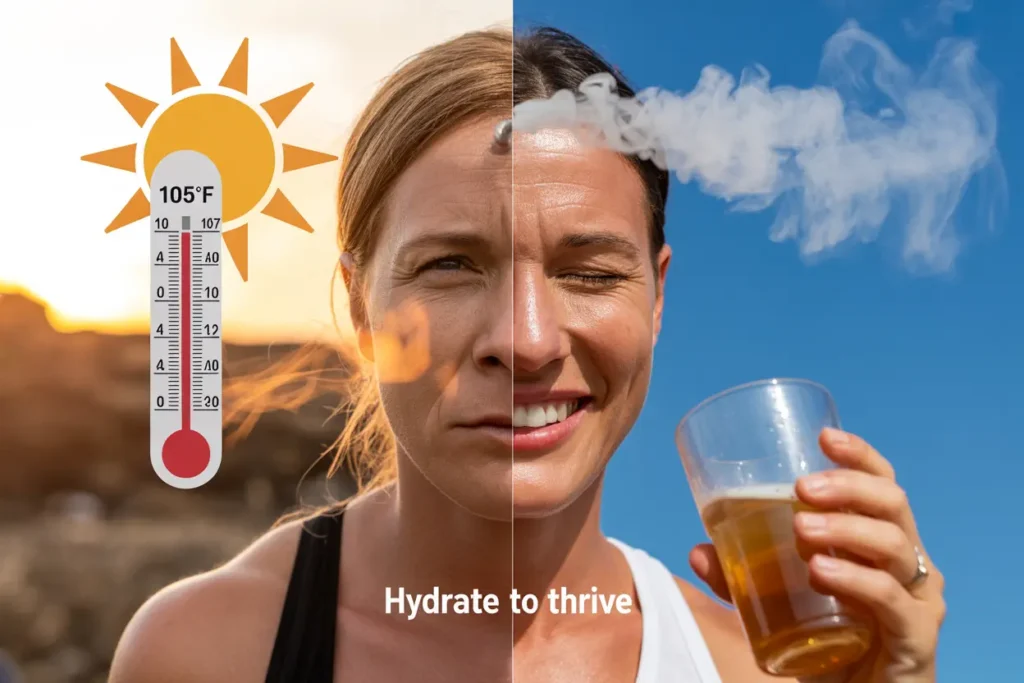
The most successful barbecue hydration doesn’t start when guests arrive—it begins days before with thoughtful preparation.
| Hydration Timeline Stage | Guest Actions | Host Actions |
|---|---|---|
| 2 Days Before | Begin increasing water intake | Purchase supplies, prepare make-ahead infusions |
| 1 Day Before | Drink 8-10 glasses of water | Set up the hydration station, prepare ice |
| Morning of Event | Drink 16-20 oz upon waking | Visit the hydration station every 30-45 mins |
| 1-2 Hours Before | Drink 16 oz of water | Fill all containers, add final garnishes |
| During Event | Ensure water is positioned near the alcohol service | Monitor supplies, encourage hydration |
| After Active Activities | Increase water intake | Offer specific hydration options for active guests |
| Post-Alcoholic Drinks | Visit the hydration station every 30-45 minutes | Drink 8 oz of water per alcoholic beverage |
| Before Leaving/End of Event | Drink 16 oz of water | Offer to-go water options for guests |
Creating Memorable Hydration Stations That Enhance Your Barbecue
A well-designed hydration station does more than provide water—it becomes a focal point of your barbecue that actively encourages guests to stay hydrated while adding to your event’s aesthetic appeal.
“The number one mistake I see hosts make is placing the hydration station too far from the main gathering areas,” notes event designer Olivia Chen. “When drinks are out of sight, they’re out of mind.”
Strategic placement recommendations include:
- Position your main hydration station in a visible, high-traffic area
- Create smaller satellite stations if your gathering spans multiple areas
- Ensure at least one station is in shade to keep drinks cooler longer
- Place a dedicated station near children’s play areas
- Consider a station near the grill for the chef and food servers
- Position water dispensers near alcohol service to encourage alternating drinks
Setting up a self-serve beverage bar elevates your summer events and encourages better hydration while reducing your workload as host.
A complete hydration station requires more than just beverages:
- Large beverage dispensers (at least 1-2 gallons each)
- Smaller pitchers for specialized options
- Ice buckets with tongs or scoops
- Various glassware or recyclable/compostable cups
- Straws (paper or reusable)
- Garnish trays with fresh fruits and herbs
- Drink stirrers or muddlers
- Napkins
- Clear, attractive signage for different beverages
- Tabletop trash and recycling receptacles
Catering to Diverse Hydration Needs at Your Gathering
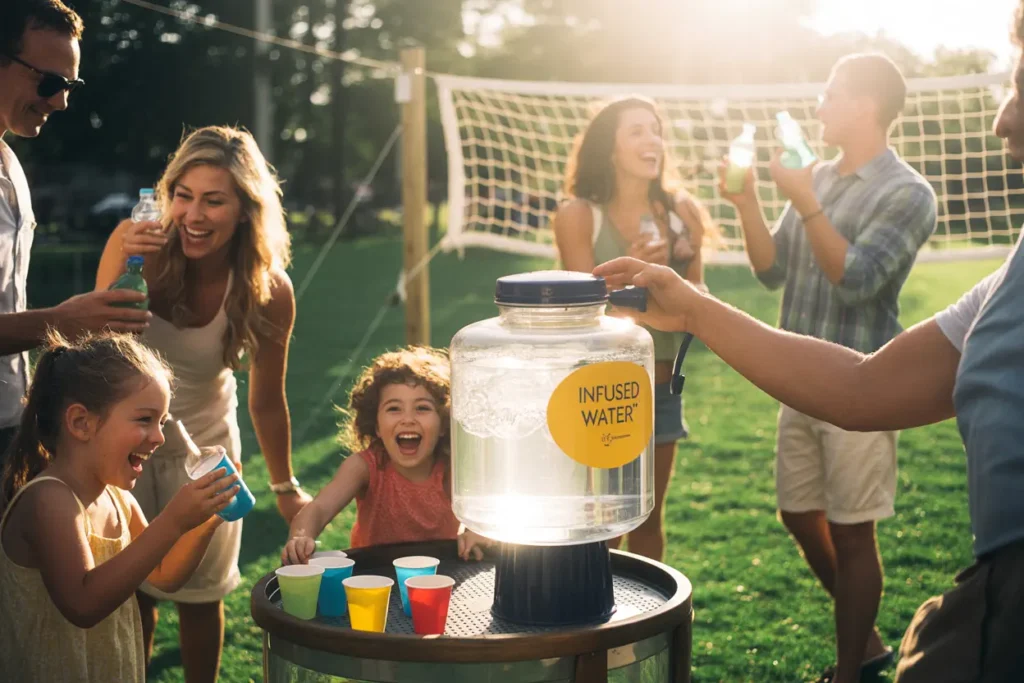
A truly inclusive barbecue acknowledges that different guests have different hydration requirements.
Children often forget to drink water during exciting events but have greater hydration needs relative to their body size. Effective strategies include:
- Setting up a kid-height hydration station with smaller cups
- Offering fruit-infused waters with familiar flavors like strawberry and apple
- Creating fun ice cubes with small toys or fruit pieces frozen inside
- Using colorful reusable straws that make drinking more engaging
- Implementing a simple “hydration game” where kids get a small prize after drinking a certain number of cups
Older adults face several hydration challenges including diminished thirst sensation, potential mobility limitations, medication interactions that may increase dehydration risk, and concerns about too-frequent bathroom trips.
Guests playing volleyball, swimming, or engaging in other physical activities will have significantly higher hydration needs and benefit from dedicated “active recovery” stations with electrolyte-enhanced options.
What’s Your Hydration Personality?
Discover your hydration style and get personalized recommendations:
Beyond Plain Water: Delicious Hydration Options for Your Barbecue
Fruit-Infused Waters: Nature’s Hydration Enhancers
Plain water is excellent for hydration, but infused options can entice even reluctant water drinkers to stay properly hydrated.
| Fruit Combination | Flavor Profile | Health Benefits | Preparation Time |
|---|---|---|---|
| Cucumber + Mint + Lime | Refreshing, spa-like | Aids digestion, cooling | 2-4 hours |
| Watermelon + Basil | Sweet, herbaceous | Hydrating, anti-inflammatory | 2-3 hours |
| Strawberry + Lemon + Thyme | Sweet-tart, aromatic | Vitamin C, antioxidants | 3-4 hours |
| Blueberry + Orange + Ginger | Complex, warming | Antioxidants, digestion aid | 4-6 hours |
| Pineapple + Coconut Water + Mint | Tropical, refreshing | Electrolytes, enzymes | 2-3 hours |
“The magic happens when you pair fruits with complementary herbs,” explains culinary herbalist Maria Garcia. “The herb compounds help extract and enhance the fruit flavors while adding their own therapeutic properties.”
Exploring refreshing fruit-infused water recipes offers delicious hydrating options that guests will love at your summer gathering.
For maximum flavor extraction:
- Soft Fruits (berries, melons, tropical fruits):
- Slice or lightly crush to release juices
- Infuse for 2-4 hours before serving
- Remove fruits after 4-6 hours to prevent over-extraction or bitterness
- Hard Fruits (apples, pears) and Citrus:
- Slice thinly to increase surface area
- Infuse for 4-8 hours for maximum flavor
- Citrus rinds can become bitter after 12 hours, so remove if storing longer
- Herbs and Spices:
- Gently bruise herbs to release essential oils
- Add woody herbs (rosemary, thyme) earlier in the process
- Add delicate herbs (mint, basil) just 1-2 hours before serving
Hydrating Mocktails: Sophisticated Non-Alcoholic Options
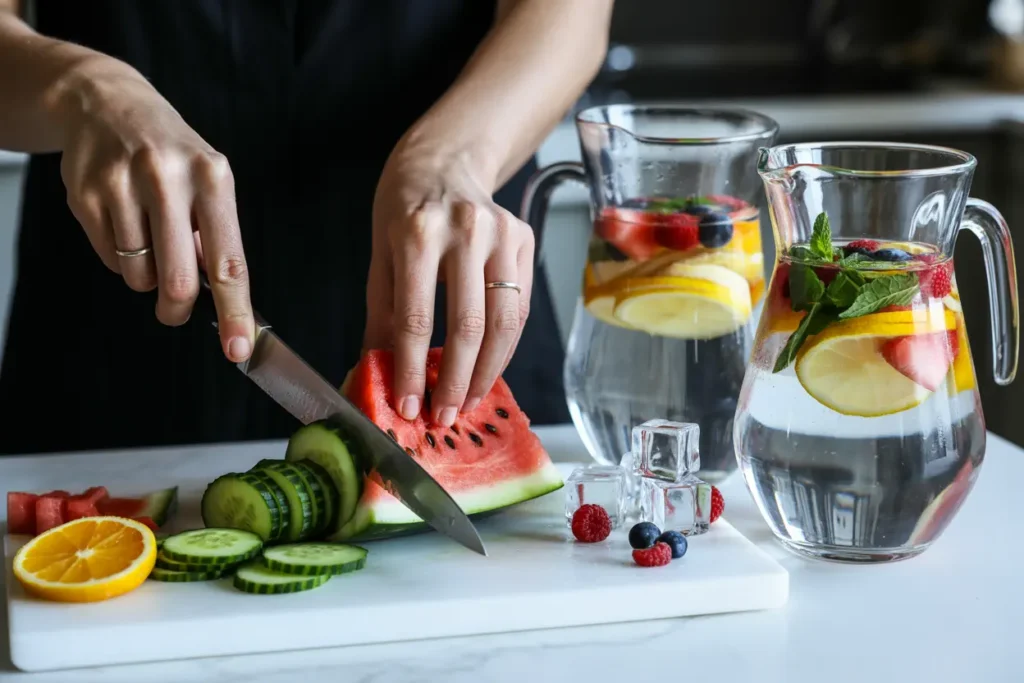
Modern mocktails have evolved far beyond simple juice mixtures, offering complex flavor profiles that rival their alcoholic counterparts while providing superior hydration.
The best hydrating mocktails balance flavor with functional benefits:
- Base liquids: Coconut water, aloe vera juice, or electrolyte waters provide hydration beyond plain water
- Natural sweeteners: Honey, maple syrup, or monk fruit extract in modest amounts
- Flavor enhancers: Bitters, shrubs, kombucha, or drinking vinegars add complexity
- Functional additions: Chia seeds, adaptogens, or herbal extracts for added benefits
- Textural elements: Muddled fruits, herbs, or carbonation for sensory interest
“The secret to a truly great mocktail is balancing five key elements: sweetness, acidity, bitterness, dilution, and aromatics,” explains beverage consultant Kim Lee. “This creates the complexity that makes it feel like a genuine cocktail experience.”
Discovering unique mocktail recipes will impress guests looking for non-alcoholic options at your summer gathering and help everyone stay better hydrated.
Functional Hydration: Performance-Enhancing Beverage Options
For active barbecues or particularly hot days, consider options that go beyond basic hydration to address specific physiological needs.
| Beverage Type | Hydration Efficiency | Electrolyte Content | Sugar Content | Best Used For |
|---|---|---|---|---|
| Plain Water | Good | None | None | Basic hydration, short activities |
| Infused Water | Good | Low | Very Low | Encouraging increased intake, mild activities |
| Coconut Water | Excellent | High (K+, Mg+) | Moderate | Recovery, medium-intensity activities |
| Homemade Electrolyte Drink | Excellent | Customizable | Low-Moderate | Extended outdoor activities, alcohol recovery |
| Watermelon Juice | Very Good | Moderate (K+) | Moderate | Pre-hydration, sweet cravings |
| Commercial Sports Drinks | Good | Moderate (Na+) | High | Intense activities, emergencies only |
| Herbal Teas | Good | Low-Moderate | None | Relaxation, gentle hydration |
| Alcohol | Poor | None | Varies | Avoided when hydration is primary concern |
Creative Ice Ideas: Elevating the Visual Appeal of Hydration
Ice is often overlooked as a simple cooling element, but it can become both a functional and aesthetic enhancement to your hydration station.
Infused ice cubes slowly release flavor as they melt, creating an evolving beverage experience:
- Citrus segments + mint leaves: Classic refreshing combination
- Berries + basil: Sweet-savory balance that complements many beverages
- Cucumber + dill: Sophisticated spa-like flavor profile
- Pineapple + coconut water: Tropical flavor that won’t dilute drinks
- Edible flowers + honey: Subtly sweet with stunning visual appeal
Creating visually appealing ice cubes with fruits and herbs enhances your summer drink presentations and makes hydration more appealing to guests.
The Science of Hydration’s Impact on Guest Experience
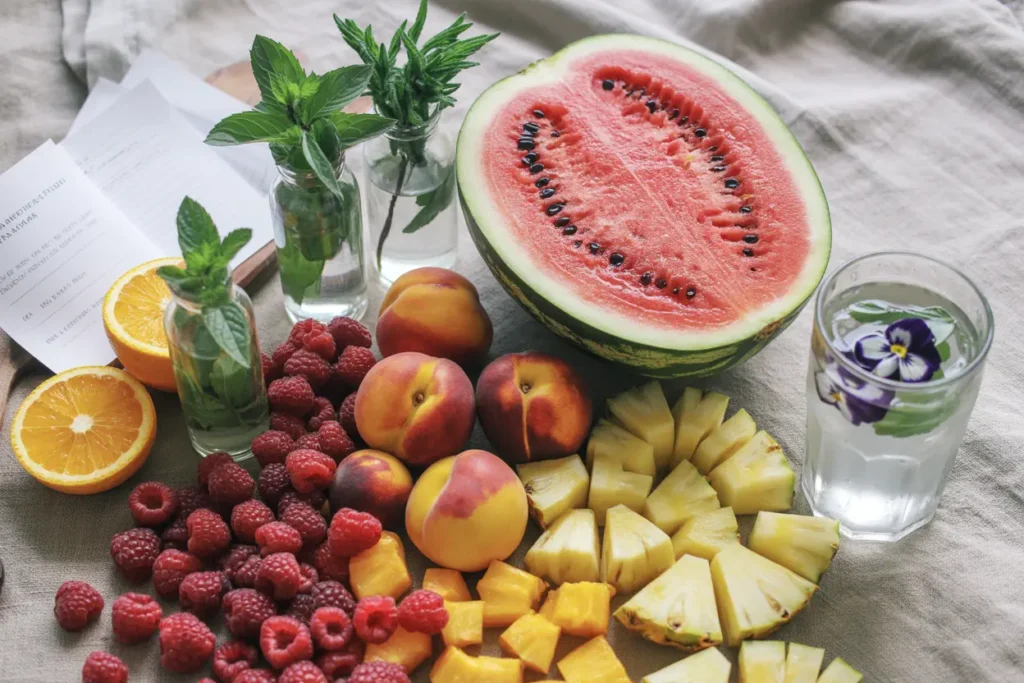
Energy Levels and Mood: How Hydration Affects Social Engagement
The quality of social interactions at your barbecue is directly influenced by guests’ hydration status, often in ways that aren’t immediately obvious.
Research shows that even mild dehydration (1-2% of body weight) can:
- Reduce working memory by up to 28%
- Decrease visuomotor skills by 23%
- Impair concentration and increase perceived task difficulty
- Negatively impact mood, particularly increasing tension and anxiety
“In a social setting like a barbecue, these cognitive effects manifest as shortened attention spans, difficulty following conversations, and less patience with others,” explains social psychologist Dr. Rebecca Coleman. “Well-hydrated guests simply make better conversationalists.”
Many hosts have witnessed the mid-afternoon energy dip that can occur at longer gatherings. This “barbecue fatigue” is often primarily a hydration issue:
“What people attribute to food coma after eating is frequently dehydration combined with heat exposure,” notes event physician Dr. Andrew Park. “Strategic hydration can prevent this energy crash and extend the enjoyable portion of your gathering by hours.”
Understanding how hydration impacts guests’ enjoyment is crucial for hosting successful summer events where everyone remains energetic and engaged throughout the event.
Cognitive Function and Decision Making at Social Events
The impact of hydration on brain function has particular implications in social settings where judgment, decision-making, and reaction time affect everything from conversation to safety.
Research indicates that dehydration can:
- Increase perception of task difficulty by up to 40%
- Reduce alertness and concentration
- Decrease short-term memory recall
- Impair visual and spatial processing
- Reduce ability to assess risk appropriately
Physical coordination and cognitive function are both essential for enjoying typical barbecue activities:
- Motor skills for yard games: Throwing accuracy decreases by up to 17% with mild dehydration
- Strategic thinking for board games: Planning ability reduces by approximately 12%
- Reaction time for active games: Slows by 7-10% with just 1% body water loss
- Sustained attention for conversations: Decreases by up to 23%
Alcohol’s dehydrating effects compound cognitive impairment beyond its direct influence on brain function. Each alcoholic drink can lead to an additional 50-80ml of water loss, while alcohol suppresses antidiuretic hormone, increasing urine production.
Temperature Regulation and Physical Comfort
One of the primary benefits of proper hydration at barbecues is its direct impact on thermal comfort and temperature regulation.
“Most people don’t realize that adequate hydration can make a 3-5°F difference in how hot a person feels in identical conditions,” explains thermal physiology researcher Dr. Maria Santiago. “This is because well-hydrated bodies can dissipate heat more efficiently through increased blood flow to the skin and more effective sweating.”
Strategic environmental design can support better hydration:
- Position seating in naturally cooler areas to reduce fluid losses
- Create “cooling zones” with misters or fans near hydration stations
- Use light-colored tablecloths and umbrellas to reflect rather than absorb heat
- Set up handwashing stations that double as cooling opportunities
- Consider timing your event to avoid peak heat hours (typically 1-4 PM)
The perfect summer barbecue requires thoughtful planning around guest comfort and hydration to ensure everyone enjoys the entire event regardless of temperature.
Seasonal and Local Approaches to Barbecue Hydration
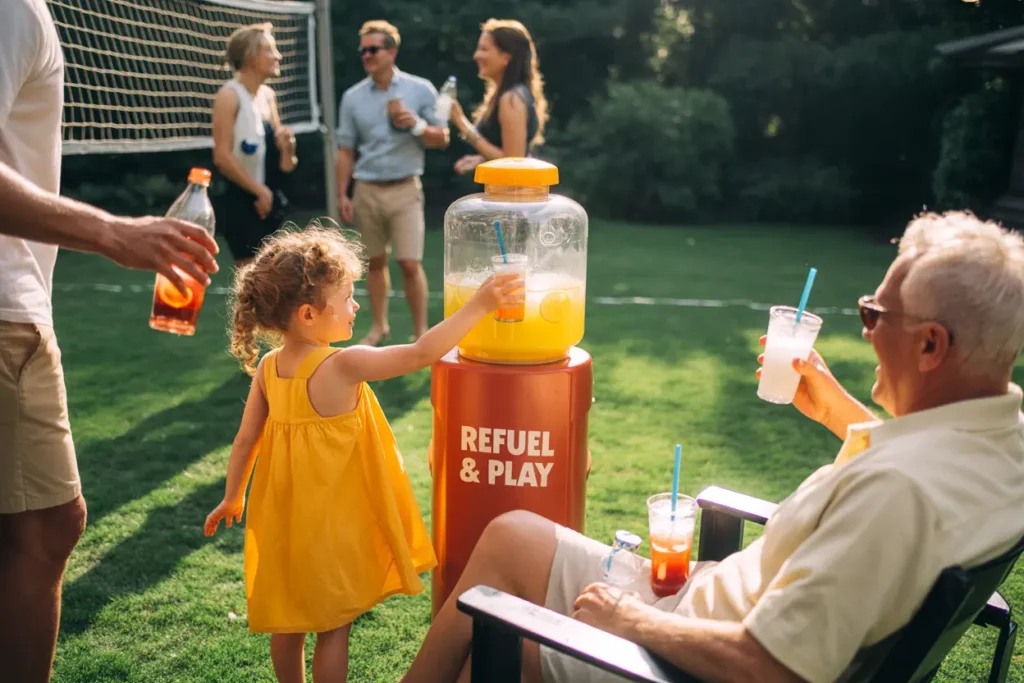
Leveraging Seasonal Produce for Enhanced Hydration
| Season | Top Hydrating Fruits | Complementary Herbs | Functional Benefits | Best Preparation Methods |
|---|---|---|---|---|
| Spring | Strawberries, cucumbers, citrus | Mint, basil, thyme | Gentle detoxification, vitamin C | Light infusions, shorter steeping time |
| Summer | Watermelon, stone fruits, tropical fruits | Mint, basil, lavender | Maximum hydration, electrolyte balance | Cold infusions, frozen fruit additions |
| Early Fall | Apples, pears, late melons | Rosemary, cinnamon, ginger | Immune support, warming properties | Warm-to-cool infusions, spice additions |
Spring’s produce has a lightness and brightness that’s perfect for gentle hydration as the weather begins to warm. Strawberries, meyer lemons, cucumbers, early-season melons, mint and basil all offer sweet hydration with clean, bright profiles.
Summer’s bounty offers exceptional hydration options including watermelon (92% water), peaches and nectarines, pineapple, berries, and tomatoes (94% water). “Summer fruits contain not just more water but higher electrolyte content, particularly potassium,” notes nutritionist Dr. Sarah Peterson. “This makes them functionally superior for intense heat hydration needs.”
As barbecue season extends into early fall, transition to hydrating options like apples, pears, late-season melons, concord grapes, and early-season citrus. “Fall hydration should incorporate warming elements to balance the cooling effects of hydration,” suggests herbalist Lisa Chen. “Spices like cinnamon, ginger, and cardamom pair beautifully with fall fruits while supporting circulation.”
Sourcing Local Ingredients for Your Hydration Station
Beyond seasonality, locality offers additional benefits for your barbecue hydration options. Farmers markets provide uniquely advantageous ingredients for hydration stations:
- Freshness: Produce picked within 24-48 hours retains more water and nutrients
- Variety: Unusual varieties not found in supermarkets offer unique flavor profiles
- Peak ripeness: Fully ripened fruits have developed optimal sugar-acid balance
- Farmer guidance: Direct advice on selection and usage from the growers themselves
Using locally sourced ingredients in summer drink recipes enhances both flavor and supports your community while providing the freshest hydration options.
Many communities have local beverage artisans creating products perfect for hydration stations, including kombucha brewers, shrub makers, honey producers, herb farms, and fruit preservers. For the adventurous host, safely foraged ingredients can create truly distinctive hydration offerings.
Current Trends in Hydrating Beverages for Summer 2025
Recent social media trends influencing hydration include:
- “Spa waters”: Ultra-premium infused waters with elaborate visual presentations
- “Hydration layering”: Creating visually striking gradient effects in clear vessels
- “Garden-to-glass”: Emphasizing hyperlocal and foraged ingredients
- “Functional hydration”: Waters enhanced with adaptogens, collagen, or probiotics
- “Zero-proof cocktail hours”: Sophisticated non-alcoholic social rituals
Staying updated with the latest summer drink trends can help you create a memorable barbecue experience that guests will want to share on their social channels.
Health-conscious guests increasingly expect beverages with functional benefits like adaptogens, nootropics, gut-health supports, anti-inflammatory additions, and protein-infused options. “The modern hydration station is increasingly becoming a wellness station,” explains nutrition researcher Dr. Leila Patel.
Barbecue Hydration Calculator
Calculate how much water you need based on your weight, activity level, and temperature:
85°F
Practical Planning: Setting Hosts Up for Hydration Success
Quantity Planning: Never Run Out of Refreshments
Different guests have dramatically different hydration needs:
| Guest Type | Water Per Hour (warm weather) | Total for 4-Hour Event | Ice Needs | Specialty Beverages |
|---|---|---|---|---|
| Average Adult | 16-20 oz (2-2.5 cups) | 64-80 oz (0.5-0.625 gallons) | 2 lbs for drinks + cooling | 2-3 servings |
| Active Adult | 24-32 oz (3-4 cups) | 96-128 oz (0.75-1 gallon) | 3-4 lbs | 3-4 servings |
| Child (5-12) | 8-12 oz (1-1.5 cups) | 32-48 oz (0.25-0.375 gallons) | 1 lb | 2-3 child servings |
| Teen | 12-16 oz (1.5-2 cups) | 48-64 oz (0.375-0.5 gallons) | 1.5-2 lbs | 3-4 servings |
| Elderly Guest | 12-16 oz (1.5-2 cups) | 48-64 oz (0.375-0.5 gallons) | 1.5-2 lbs | 1-2 servings |
| Pregnant Guest | 16-24 oz (2-3 cups) | 64-96 oz (0.5-0.75 gallons) | 2 lbs | 3-4 non-alcoholic servings |
“I recommend calculating your total water needs and then adding 25% as a safety buffer,” advises event planner Sophie Williams. “It’s always better to have too much than not enough, and unused water can be sent home with guests in refillable bottles.”
Proper event planning ensures your barbecue has sufficient hydration options for all guests throughout the entire gathering.
Adequate ice is crucial for both cooling beverages and adding to drinks:
- Beverage cooling: 1 pound of ice per quart of liquid
- Drink ice: ½ pound per guest per hour
- Ice bucket refills: Replace approximately every 2 hours in warm weather
- Backup ice: Additional 2-3 pounds per guest for unexpected needs
Budget-Friendly Hydration Solutions That Impress
Creating a memorable hydration experience doesn’t have to break the bank. Inexpensive additions that transform ordinary water include:
- Frozen fruit: Use as both ice and flavor enhancer
- Bulk citrus: Lemons, limes, and oranges purchased by the bag
- Herb sprigs: Growing your own mint, basil, or rosemary costs pennies per serving
- Cucumber slices: One cucumber flavors multiple gallons of water
- Tea bags: Herbal teas can infuse water with complex flavors at minimal cost
“The secret to budget-friendly flavor is using highly aromatic ingredients in small quantities,” advises food economist Maya Zhang. “For example, a single sprig of rosemary or three thin slices of fresh ginger can flavor an entire pitcher because their essential oils are so potent.”
Efficient planning reduces both cost and day-of stress through the concentrate method, freezer prep, multi-use ingredients, buying club approach, and seasonal purchasing.
Sustainable Hydration: Environmental Considerations for Modern Hosts
Eliminate single-use plastics with alternatives like glass dispensers and pitchers, stainless steel or copper vessels, compostable cups if disposables are necessary, real glassware (consider renting if you don’t own sufficient quantities), and designated water bottles.
“The average barbecue with plastic cups generates about 1-2 pounds of plastic waste per guest,” notes environmental researcher Dr. James Thompson. “Switching to reusable or truly compostable options essentially eliminates this waste stream.”
Complete your sustainable approach with proper waste management through clearly labeled stations, citrus composting, herb stem collection, water conservation, and education signage.
Pairing Hydration with Barbecue Favorites: A Flavor Guide
Classic Barbecue Dishes and Their Ideal Hydration Companions
Smoked meats like brisket and ribs benefit from beverages that cut through richness:
- Citrus-forward waters: Lemon, lime, or grapefruit infusions provide acidic contrast
- Berry and herb combinations: Strawberry-basil or blueberry-mint offer fruity brightness
- Cucumber-based options: Clean, vegetal notes cleanse the palate between bites
- Watermelon infusions: Sweet-water balance refreshes without competing
Specific recommended pairings:
- Texas brisket + grapefruit-rosemary water
- Smoked ribs + watermelon-mint infusion
- Pulled pork + peach and lime water
- Smoked turkey + cucumber-lemon-thyme water
Learning how to pair seasonal beverages with summer dishes creates a perfect barbecue experience where each element enhances the others.
Spicy barbecue dishes require strategic hydration companions with mint-forward beverages, coconut water blends, cucumber and melon waters, sweet fruit infusions, and aloe vera additions. “When pairing beverages with spicy foods, you’re not just addressing flavor but also physical sensations,” notes culinary scientist Dr. James Chen.
Sweet barbecue sauces and glazes require balanced beverage companions like tart berry infusions, citrus-forward options, herbal additions, and slightly bitter elements. “The key principle when pairing with sweet barbecue is providing acid balance,” explains chef Marcus Williams.
Frequently Asked Questions About Barbecue Hydration
What’s your favorite hydrating mocktail base at summer barbecues?
| Question | Expert Answer |
|---|---|
| How much water should I provide per guest? | Plan for 1 gallon (128 oz) of total beverages per guest for a 4-hour daytime summer barbecue. This includes approximately 64 oz of plain water and 64 oz of other beverages. For longer events or extremely hot days, increase to 1.5 gallons per guest. |
| Can I prepare hydration station elements the day before? | Absolutely! Most infused waters actually benefit from 12-24 hours of infusion time. Prepare your base liquids and store them covered in the refrigerator. Keep cut garnishes in water-filled containers to maintain freshness, and assemble your station shortly before guests arrive. |
| How do I calculate ice needs for a large gathering? | For a typical barbecue, plan on 1.5 pounds of ice per person for a 4-hour event. This includes ice for drinks (0.5 lb per person), cooling beverages (0.5 lb per person), and backup/emergency ice (0.5 lb per person). In very hot weather, increase to 2 pounds per person. |
| What’s the best way to keep drinks cold without electricity? | Pre-chill beverages thoroughly (24+ hours in refrigerator), use insulated dispensers, create shade for your hydration station, utilize frozen fruit instead of ice when possible, rotate smaller quantities rather than putting everything out at once, and consider burying containers partially in dirt or sand for natural insulation. |
| What are the warning signs that a guest is becoming dehydrated? | Watch for decreased engagement in conversations, unusual quietness, flushed appearance, increased irritability, headache complaints, dizziness when standing, decreased urination, significantly dry lips, excessive sweating followed by no sweating, and confusion or disorientation. These signs warrant immediate hydration intervention. |
Conclusion: Elevating Your Barbecue Through Hydration Excellence
The difference between an ordinary barbecue and a truly memorable gathering often comes down to those elements that guests might not consciously notice but significantly impact their experience. Proper hydration is precisely this kind of detail—a foundational element that affects every aspect of the event from physical comfort to flavor perception to social engagement.
By implementing the strategies in this guide, you’re not just preventing the negative effects of dehydration; you’re actively enhancing your barbecue experience through thoughtful hydration planning. The beauty of focusing on hydration is that it’s both practical and creative—an opportunity to express your hosting style while meeting an essential need.
Remember these key principles as you plan your next barbecue:
- Begin with understanding the science of how hydration affects the body in outdoor settings
- Plan comprehensively for adequate quantities and variety
- Create visually appealing hydration stations that encourage regular drinking
- Offer options that complement your food menu and overall theme
- Consider the diverse needs of different guest types
- Use seasonal and local ingredients for maximum flavor and freshness
- Pay attention to presentation details that enhance the experience
With these elements in place, you’ll create a barbecue where guests leave not only well-fed but also feeling refreshed, energized, and eager to accept your next invitation.
Essential Hydration Checklist
✓ Calculate beverage quantities based on guest count, duration, and weather
✓ Plan your hydration station location(s) for maximum visibility and usage
✓ Prepare at least three different beverage options beyond plain water
✓ Ensure adequate ice supply and proper storage
✓ Create clear, attractive signage for different beverage options
✓ Establish a refill and maintenance plan for during the event
✓ Consider sustainable serving options that reduce waste
✓ Prepare garnishes and additions that enhance both flavor and presentation
✓ Plan specific hydration options to pair with your menu items
✓ Set up shade protection for your hydration station
The most successful hosts understand: hydration isn’t just a practical necessity – it’s an opportunity to demonstrate thoughtfulness and creativity while ensuring everyone enjoys your barbecue to the fullest. Here’s to your next refreshing, memorable gathering!

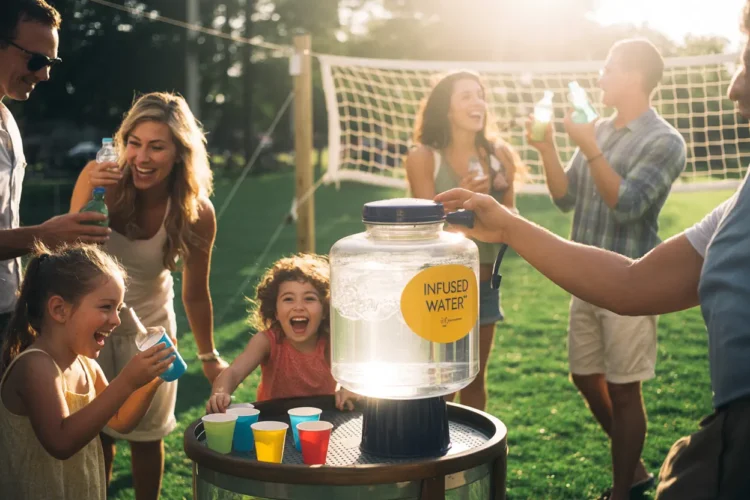
Pingback: Mocktail Mixology Basics: Fail Proof Art of Non-Alcoholic Drinks - Whaley Cooks